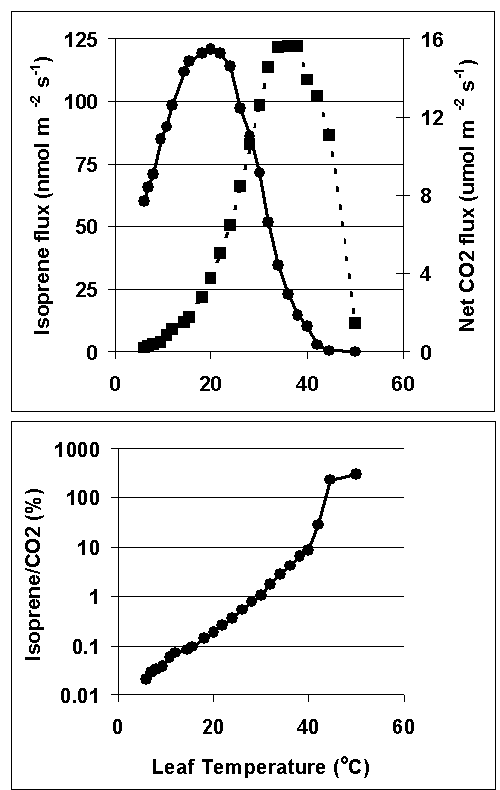
Impact of the Biosphere on Atmospheric Composition and Trace Gases
Biosphere-Atmosphere Interactions
The Biosphere-Atmosphere Interactions (BAI) Group (Alex Guenther, William Baugh, James Greenberg and Peter Harley) conducts research to characterize terrestrial sources and sinks of trace gases and aerosols, factors controlling their emissions, and the influence of these emissions on the chemical composition of the atmosphere. Their focus in FY 2001 was on biogenic volatile organic compound (BVOC) emissions, including oxygenated BVOCs, and secondary organic aerosol production. These activities were directed toward the characterization of BVOC sources for regional and global atmospheric chemistry and transport models, and consisted of laboratory studies to investigate processes controlling fluxes and field studies aimed at the development and application of trace gas concentration and flux measurement techniques in various ecosystems. FY 2001 field campaigns were conducted in Brazil, South Africa, Botswana, Finland, China, Michigan and Colorado.
Large-Scale Biosphere-Atmosphere (LBA) in Amazonia (Brazil)
BAI efforts are an important
component of an international investigation of the
climatological, ecological, biogeochemical, and hydrological functioning of
Amazonia, the impact of land use change on these functions, and the interactions
between Amazonia and the Earth system (see http://www-eosdis.ornl.gov/lba_cptec/)The
BAI objectives are to quantify biogenic emissions from tropical forests, and
their role in the formation of photochemical oxidants and aerosols, and determine
how these processes will be influenced by landcover and climate change. During FY01, the BAI group completed two additional field campaigns in
the Brazilian Amazon that included VOC flux measurements made with enclosures,
tethered balloon profiling systems and two flux towers. BAI scientists worked with Theresa Johnson (NCAR SOARS program), Paulo
Artaxo, Luciana Varanda Rizzo, Ana Maria
Cordova (University of Sao Paulo, Brazil) and Lucianna Vanni Gatti, Perola Vasconcellos
and Oscar Vega (Institute Pesquisas Energeticas e Nucleares, Brazil).
VOC Emissions from Fall Foliage (Michigan)
BAI scientists worked with Raymond Fall (University of Colorado) and Barkley Sive (Central Michigan University) to investigate emissions of methanol, acetaldehyde, acetone and other compounds that are emitted when leaves senesce and fall during autumn. An FY01 field study was conducted at the Program for Research on Oxidants: Photochemistry Emissions and Transport (PROPHET) field site in Northern Michigan and hosted by Mary Anne Carroll (University of Michigan). This effort used a disjunct eddy covariance technique with analysis by chemical ionization mass spectroscopy (CIMS). The results indicate that large amounts of oxygenated compounds such as methanol and acetaldehyde are emitted from deciduous forests in autumn.

Figure 1: Temperature dependence of net photosynthesis (circles and solid line) and isoprene emission (squares and dashed line) from a single eucalyptus leaf. The percent carbon ratio of isoprene to net photosynthesis is shown at bottom.
Origin and Formation of Secondary Organic Aerosol (OSOA) (Finland)
BAI scientists made an important
contribution to this international investigation of the role of biogenic compounds
in the formation and growth of (see
http://www.isas-dortmund.de/2001/e/groups/321/osoa/osoa.html). During FY01, the BAI group operated two tethered balloon systems at
a Finnish boreal forest site to measure vertical profiles of VOC concentrations
and particle number densities. BAI
scientists worked with Casimiro Pio (University of Aviero, Portugal), Thorsten
Hoffman (Institut fur Spektrochemie und Angewandte Spektroskopie, Germany) and
Markku Kulmala (University of Helsinki, Finland).
South African Regional Science Initiative (SAFARI) (South Africa, Botswana)
BAI scientists had a lead
role in investigating biogenic emissions as part of this international research
program designed to explore, study and address linkages
between land-atmosphere processes and the relationship of biogenic, pyrogenic
or anthropogenic emissions and the consequences of their deposition to the functioning
of the biogeophysical and biogeochemical systems of southern Africa (see http://safari.gecp.virginia.edu/). During FY01, the BAI group operated eddy flux systems and leaf enclosure
systems to characterize biogenic VOC fluxes at two savanna sites (Skukuza, South
Africa and Maun, Botswana). BAI scientists worked with Luanne Otter (University of Witwatersrand, South
Africa), Elmar Veenendaal (University
of Botswana), C. Nicholas Hewitt and Susan Owen (Lancaster University, United
Kingdom).
Temperate (Colorado) and Tropical (China) Forests
BAI scientists are analyzing data from previous field studies in forest landscapes and conducted additional biogenic VOC flux studies in China and Colorado. The field measurements from both regions are being used to improve and evaluate model predictions of emissions. The Colorado effort is associated with the AMERIFLUX network (see http://www.esd.ornl.gov/programs/NIGEC/ ) and is in collaboration with Russell Monson and Andrew Turnipseed (University of Colorado). The China effort is conducted in collaboration with Bai Jianhui (Institute for Atmospheric Physics, China), Qing-Jun Li (Chinese Academy of Sciences) and Bradford Baker (South Dakota Institute of Science and Technology).
Laboratory Studies (NCAR Mesa Lab FLUXTRON)
BAI scientists conducted investigations of the physiological processes controlling isoprene emissions from poplars and monoterpene emissions from pine and spruce using automated enclosure and analytical systems at NCAR. This work was conducted in collaboration with Fall (University of Colorado).